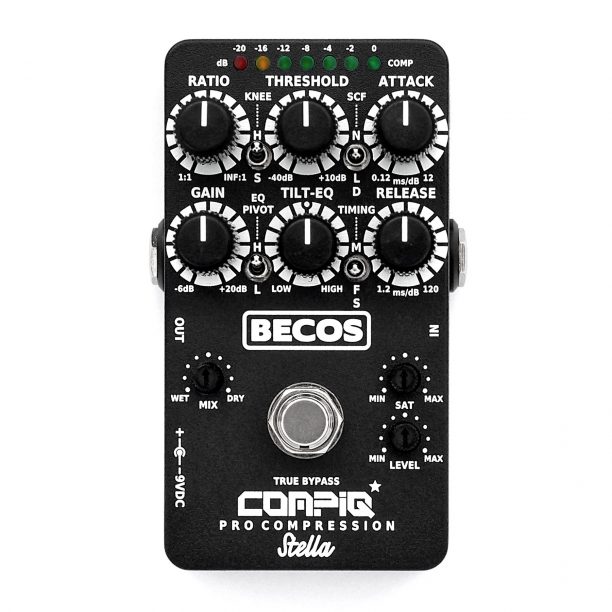
Those of you who like their compressor fully featured should take a look at the CIQ-5 Compiq Pro Stella from Romanian company BECOS.
Hosted in your regular compact case, the CIQ-5 is a VCA-style analog compressor that packs a truly impressive amount of features, including:
- True RMS-level detector
- Ratio 1:1 – inf:1 (limiter)
- Threshold -40dB to +10dB
- Make-up Gain -6dB to +20dB
- Tilt-EQ with selectable frequency pivot 330Hz/1KHz (EQ bypass – jumper selectable)
- Manual Attack 0.12 – 12 ms/dB
- Manual Release 1.2 – 120 ms/dB
- Soft/Hard compression knee
- Manual timings or Fast/Slower dynamic auto attack and release timings
- Normal/Low/Deep sidechain filter
- Dry/Wet mix
- Tape Saturation on the dry line with Level compensation and Low/High-frequency cut filters (jumper selectable)
- 6-LED compression display
We highlighted in bold the more intriguing features, but are very excited by the tap saturation one.
Brett Kingman does a great job at showcasing all this little box can do, check out his video below.
CompIQ PRO Stella is a one-of-a-kind compressor that will blow your mind with the amount of control and versatility it provides. With features only found in expensive studio rack gear, this stellar compression effect pedal is ready for professional audio dynamic processing, ensuring the musical response and transparency of analog circuitry.
CompIQ PRO Stella Compressor is an all-analog battery operated compressor pedal designed for guitar and bass and hand-built around the top-class THAT Analog Engine® – the same technology used in rack compressors made by the likes of DBX, Presonus, Dangerous Music or Revive Audio. A true RMS-level detector measures input signal and applies accurate feed-forward compression through a transparent sounding, high-performance Blackmer® VCA. The amount of control it offers is staggering and probably never before seen in a compression pedal, especially of this size. We didn’t leave out anything that helps bring a truly clean, accurate and transparent dynamic sound processing.
With so many controls, one may wonder how can this be tamed and furthermore, properly used in a live setup. Don’t let yourself overwhelmed. We provided sufficient options not only for in-depth control but also for making things easier. For instance, with the flip of a switch, you can take out the Manual Attack & Release controls and let the Dynamic Auto Timing analog circuit do the right thing for you. Two timing choices are available – Fastor Slower – and both respond gracefully to any playing style.
The Ratio, Threshold and Gain continuous controls are quintessential to a professional compressor, and they all add to the plethora of switchable options, to further attain the ideal amount of compression effect for any musical program. A Dry/Wet Mix allows parallel compression, where the desired amount of dry input signal may be mixed with the compressed signal, for a more natural effect application.
Additional features are available for the very demanding players. Side Chain Filter has three selectable options – Normal, Low and Deep -, which are very helpful for a bass instrument or when a fuller output sound is needed. If you want to keep things simple, set the filter to Normal and the compressor will just act naturally in most instances. However, if your bass lower notes trigger compression yet too fast, then the Low or Deep setting will slightly delay the compression, freeing up the low-end frequencies just enough for the audio spectrum to breath out thoroughly. The Compression Knee can be selected between Hard and Soft, each option having its own particular sonic signature. Hard Knee compression acts fast and squishes hard – use this if you aim for a limiting effect. Soft Knee compression is progressive and gentle, helping to create a transparent effect application. The Tilt-EQ equalization circuit has two selectable options for pivot frequency – High (at 1KHz) proper for guitar and Low (at 330Hz) suitable for bass.
On top of all these controls, we added an analog Tape Saturation circuit which can add harmonic distortions to the dry line, which can then be mixed with the compressed wet line, for precise balancing of the effect. This circuit rivals vintage studio tape overload compression effect which was a studio recording trick during the ’60s. Tape saturation is a pleasing sort of distortion arising when high amplitude audio signals are recorded on magnetic tape. The Saturation control can vary in intensity from nothing to mild and warm overdrive. The result is either subtle, adding richness to the body of sound, or obvious, with a tube-like screaming distortion feel. If needed, Low and High-frequency cut filters can be engaged by removing two internal jumpers. This helps eliminate oversaturated low-frequency fuzziness or prevent high-frequency from sounding too pointy. The parallel processing is delicately brought together and leveled up with the blend knob, similarly with using a dedicated studio summing amplifier. The parallel tape saturation feature also transforms CompIQ Stella into a compressor/overdrive effect.
Ultimately, a 6-LED compression display indicates the amount of effect applied to the input signal, providing accurate feedback over how much the sound is processed. The information used for compression display is taken directly from the RMS-level sensor.
CompIQ series of compressors is not gonna alter the magic voice of your instrument. It preserves the original guitar or bass tone while providing unobstructed, pristine audio compression. The high dynamic range of these compressors allows natural-sounding clean tones and low noise artifact-free audio processing, without distortions usually introduced by optical compressors.






















